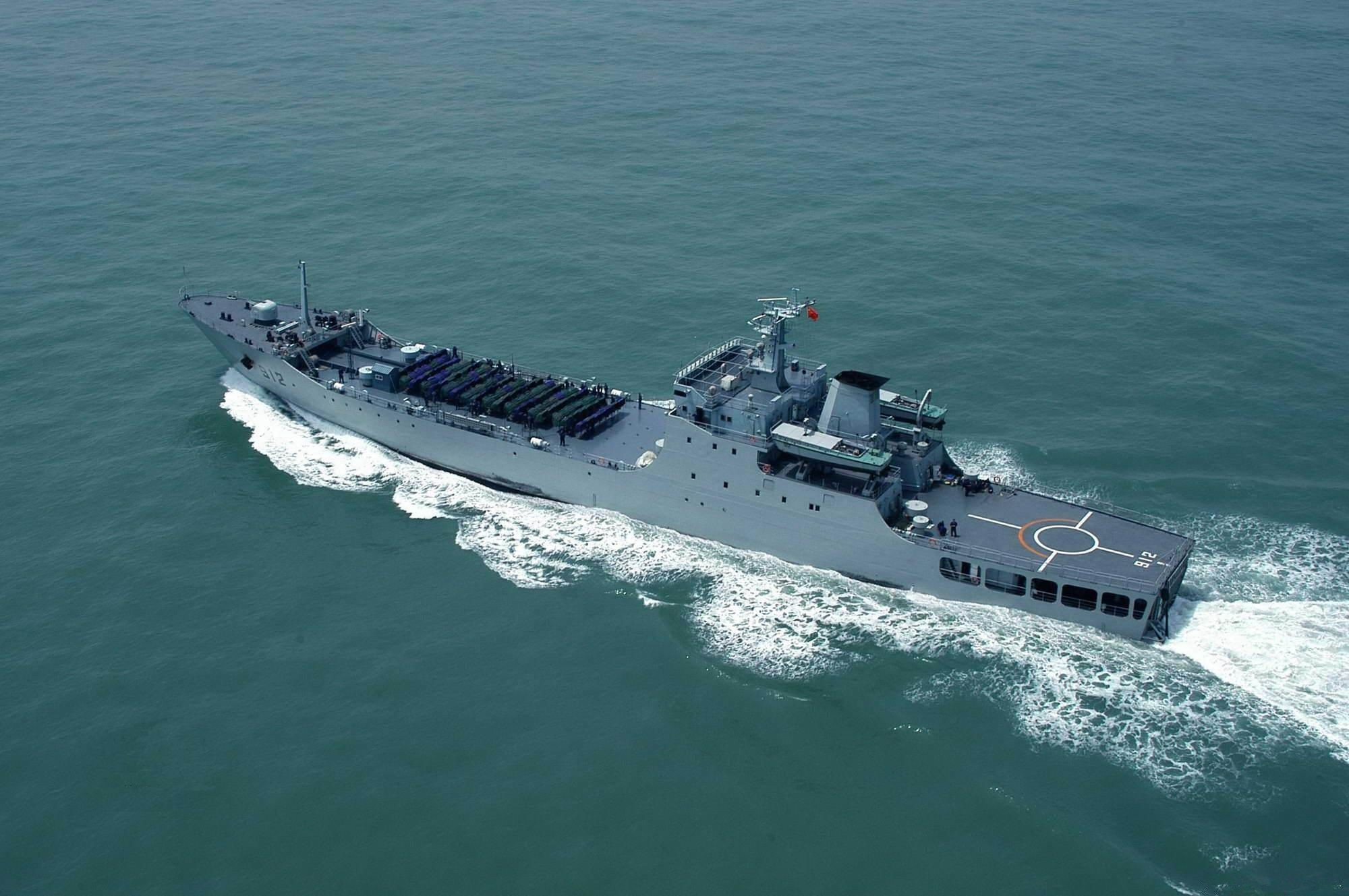As a rising power with important international interests, China has been developing its naval power projection capabilities for a number of years. Gone are the days when the Chinese navy had to muster its limited resource to undertake even a small expeditionary deployment. But despite the concern (1 and 2) in some quarters that there will be a robust Chinese naval presence ‘in their backyard’ any time soon, China remains limited in its capacity to project naval power despite its increasing capabilities.
Amphibious Capabilities
China has long maintained a vast armada of landing ships to enable an amphibious assault on Taiwan. These vessels vary greatly in terms of size and capability but all were designed for responding to a Taiwan contingency, not to project power far from China’s coastline. Until recently, China had little in the way of capabilities to conduct humanitarian assistance (i.e., following the 2004 Indian Ocean Tsunami) or to evacuate Chinese citizens overseas during times of crisis. In 2007, China commissioned the first vessel of the Type 071/Yuzhao-class amphibious warfare ship. The 20,000 ton Type 071 class constitutes China’s first attempt at developing long-range naval power projection capability.

The Type 071 is capable of carrying a battalion of marines and can carry a small number of helicopters. Additionally, it has medical facilities that make it a very useful asset for disaster response missions. Its capabilities can be best contrasted with the Type 072A-class landing ship, China’s latest class of large, Taiwan-focused landing vessels. The Type 072A displaces under 5,000 tons and can only carry a few hundred troops and a small unit of armoured vehicles over short distances. It does not have the facilities required to berth large numbers of non-crew personnel for long durations.
The Type 071-class has already been deployed to the Indian Ocean as part of China’s anti-piracy efforts. China currently has three Type 071-class ships in service. A fourth vessel is under construction with a further two rumoured to be on order. While the Type 071 provided new capabilities, it is somewhat limited in its design. The Type 071 is a very large ship but is not large enough to carry much more than a battalion of marines and their equipment for extended deployments. For a more robust expeditionary capability, China will need either more ships or larger ships.
Additionally, the class cannot carry a sufficient number of helicopters for air assault purposes. This is not so much a result of the class’ displacement but its design. China will need amphibious warfare ships built with extensive aviation facilities (‘aircraft main deck’ etc.). While Chinese shipbuilders have offered such vessels for export, China has yet to procure any for itself. Nevertheless, it is widely assumed that it will procure a number of such vessels, tentatively called the Type 081 class, in the future. Such a development would allow China to maintain significant sea-based military forces worldwide.
Replenishment Ships
Warships and amphibious ships carry limited supplies onboard, resulting in limited endurance and range. To supply warships with fuel, food and other essentials, navies operate dedicated replenishment ships. At-sea replenishment has long been a relative weakness, but one that could be overlooked as long as the Chinese navy did not frequently deploy or train far from its bases (i.e. not in the Indian Ocean). Given its ever-growing overseas interests and the maritime threats to its trade (i.e., piracy), the Chinese government has acquired more replenishment ships. In May 2014, the fifth 20-23,000 ton Type 093/Qiandaohu-class replenishment ship was launched, making it the third new replenishment ship launched since 2012. The five Qiandaohu-class vessels complement the sole Type 908/Fusu-class replenishment ship and two ageing Type 905/Fuqing-class replenishment ships.
It is expected that the Qiandaohu -class will be complemented in the future with a new, much larger class of replenishment ships that will support China’s aircraft carrier(s) and any putative Type 081-class amphibious warfare ships. Without more ships, China will not be able to deploy such fuel-hungry vessels – both are conventionally powered and have significant onboard aviation units that require a constant supply of aviation fuel – and their associated escorts at much distance for very long.
Submarine Capabilities
China maintains one of the largest submarine fleets. The bulk of this fleet is composed of conventionally powered (i.e., diesel-electric) submarines. Diesel-electric submarines are not suited for very long-range deployments. While the larger diesel-electric submarine classes in Chinese service have the necessary range to depart from a Chinese port to the Indian Ocean and stay there for a few weeks, their slow cruising speed results in very lengthy transits to and from the area of operations and results in a very short ‘on-station’ deployment duration.
There are a number of ways to alleviate this shortcoming. China can acquire naval bases/get access to naval bases in places such as the Indian Ocean region. While this is the simplest way of fulfilling this requirement, it is fraught with political difficulty. Alternatively, China can build submarine tenders. Submarine tenders perform everything a dedicated naval base and associated repair yard can, and they can resupply, refuel, rearm, and, if necessary, perform light repairs. China does not have large dedicated submarine tenders capable of supporting the deployment of a submarine(s) at long distances for extended durations, but this is a capability it is likely to develop in the future.

China’s interest in the Indian Ocean is growing, something put on public display in September 2014 when a Type 039/Song-class submarine arrived at the port of Colombo, Sri Lanka. Not having a naval base in the region or a dedicated submarine tender meant that a Chinese submarine had to publicly berth at a civilian port. While this would be routine for a surface ship, submarines rarely visit foreign ports. There are many reasons for this, one of which is that a submarine that surfaces and enters a port has given away its presence and position.
Submarine operations add an additional complexity that surface warship operations do not, the need to rescue a damaged submarine. A number of submarine disasters and the end of the Cold War have resulted in submarine rescue becoming a very multinational enterprise. Countries pool their resources, train together, and agree to assist one another should a disaster, such as the one that befell the Russian submarine Kursk in 2000 occur. While former arch-foes Russia and the United States cooperate with one another on submarine rescue, China is not part of the multinational efforts. As such, China is forced to rely on its three Type 926-class submarine rescue ships and an uncertain (but very small) number of the older Type 925/Daijing-ships.
If China is not going to sign up to multinational submarine rescue efforts and is not going to acquire a naval base abroad to forward deploy a submarine rescue ship, it may need to accompany (at a distance) every submarine it sends on extended deployments with one of the limited number of submarine rescue ships it has at its disposal. For example, when the aforementioned Chinese submarine visited Colombo, it was shadowed by a vessel from the Type 925/Daijing-class submarine rescue ship. While this is manageable when Chinese submarines intermittently deploy in the Indian Ocean, it is demanding on resources and also signals that a Chinese submarine is in the area.
China’s power projection capabilities are growing at a steady pace. While the effort is not as rapid as its surface naval combatant modernization has been, it nevertheless warrants close attention. China’s naval forces are forced to remain focused on waters close to home for as long as China lacks sufficient numbers of replenishment ships, long-range amphibious warfare ships, and submarine support vessels. This is not to say that China desires a robust, continuous overseas naval presence but that individuals concerned about a Chinese naval presence in their ‘backyard’ in the near future first look at China’s existing capabilities, not its assumed intent.




